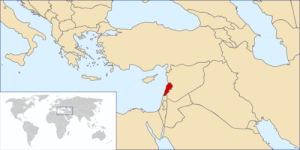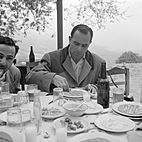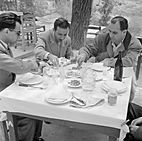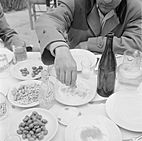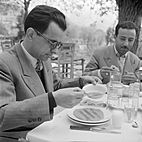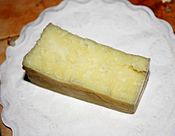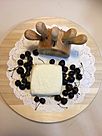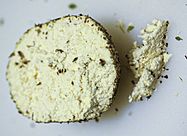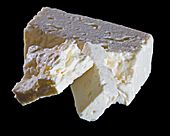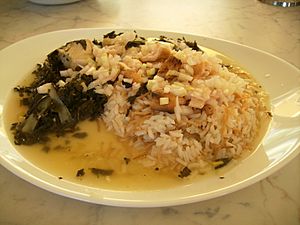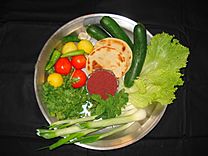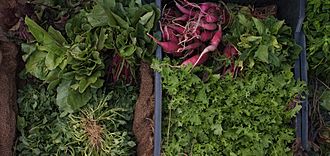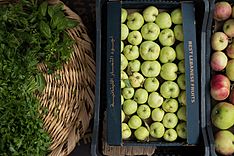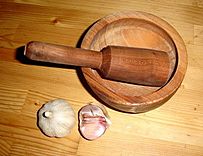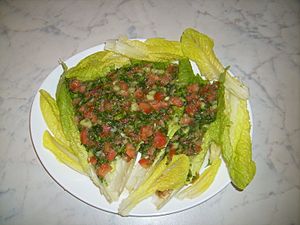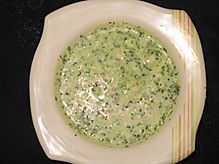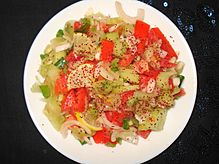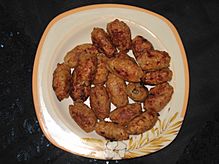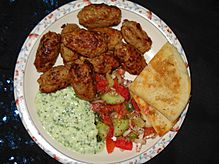Lebanese cuisine facts for kids
Lebanese cuisine is all about the yummy food traditions from Lebanon. It uses lots of healthy whole grains, fresh fruits, colorful vegetables, and tasty fish and seafood. People in Lebanon eat chicken more often than red meat. When they do eat red meat, it's usually lamb or goat.
Many Lebanese dishes use lots of garlic and olive oil. They often add lemon juice for a zesty flavor. Chickpeas and parsley are also super important ingredients in Lebanese meals.
Some famous Lebanese dishes you might know are baba ghanouj, tabbouleh, sfeeha, falafel, and shawarma. A very important part of many meals is hummus, which is a creamy dip made from chickpeas. Many dishes are eaten with flatbread. For dessert, popular choices include baklawa, sfouf, and ka'ak. Some desserts are special for certain times, like meghli (a rice pudding with spices) served when a new baby arrives!
Arak is a special drink with an anise flavor. It's the national drink of Lebanon and is often served with a traditional Lebanese meal. Lebanese wine is another old and traditional drink from Lebanon.
Contents
- A Taste of History: How Lebanese Food Evolved
- What Makes Lebanese Food Special?
- Delicious Dishes and Ingredients
- See also
A Taste of History: How Lebanese Food Evolved
Lebanese food has a very long history! It's part of the cooking traditions from the Levant, which is the eastern part of the Mediterranean region. Many dishes you find in Lebanon today have been around for thousands of years. They were influenced by different ancient civilizations that ruled the land, like the Phoenicians, Persians, Egyptians, Babylonians, Romans, Greeks, Byzantines, Arabs, and Ottomans.
For example, from 1516 to 1918, the Ottoman Turks controlled Lebanon. They brought new foods, like cooking with lamb, which became a big part of Lebanese meals. After World War I, France took over until 1943, when Lebanon became independent. The French introduced desserts like flan, caramel custard, eclairs, and pastries like croissants.
Lebanese people who live all over the world, called the Lebanese diaspora, have also added new ingredients and cooking styles. This keeps Lebanese cuisine fresh and famous both inside and outside Lebanon!
What Makes Lebanese Food Special?
Most Lebanese dishes are grilled, baked, or lightly cooked with olive oil. They rarely use butter or cream, except in some desserts. Vegetables are often eaten raw, pickled, or cooked. Just like in many Mediterranean countries, what Lebanese people eat often depends on the season and what fresh ingredients are available.
Lebanese food also changes a bit from one region to another. South Lebanon is famous for its kibbe. The Beqaa Valley is known for meat pastries like sfiha. And north Lebanon and Saida (Sidon) are famous for their delicious sweets.
In Lebanon, drinks are almost always served with food. Mezze is a collection of many small dishes, similar to tapas in Spain. These small dishes create a beautiful display of colors, flavors, and textures. Serving food this way is more common for entertaining guests or in cafés than for everyday family meals.
A simple mezze might include raw or pickled vegetables, hummus, baba ghanouj, and bread. But it can also be a huge meal with grilled seafood, skewered meats, different cooked and raw salads, and a variety of desserts. People usually eat mezze dishes in small bites using a piece of flatbread.
A typical mezze can have about 30 hot and cold dishes! These might include:
- Salads like tabbouleh and fattoush.
- Dips like hummus, baba ghanoush, and moutabal.
- Kebbeh, kafta, and falafel (fried chickpea balls).
- Small pastries like sambusac.
- Stuffed grape leaves and pickles.
- Roasted nuts, olives, and vegetables.
- Sauces like toum and taratour, which are great on sfiha.
When families eat together, mezze usually has three or four dishes. But in restaurants, it can have 20 to 60 different dishes! Family cooking also includes stews called yakhneh, which are made in many ways and usually served with meat and rice.
After a Lebanese meal, people often eat fresh fruits like figs, oranges, apples, grapes, cherries, and green plums. But there are also delicious desserts like baklava and coffee. Baklava is the most famous Lebanese dessert around the world, but there are many other sweet treats to try!
Delicious Dishes and Ingredients
Lebanese dishes are heavily influenced by the many cultures that have lived in the region. This mix has created the amazing Lebanese cuisine we know today. Using fresh, flavorful ingredients and spices, Lebanese cooking combines styles from Turkey, Arab countries, and France. Key features include using lamb (brought by the Ottomans), lots of nuts (especially almonds and pine nuts), and dressings made with lemon juice.
Bread: A Staple of Lebanese Meals
Lebanese people use bread, usually flatbread, as a very important part of their meals. Food is generally not served without it!
-
 Different types of manaeesh and other bread in a Lebanese eatery.
Different types of manaeesh and other bread in a Lebanese eatery. - Pita bread, also called khubz Arabi (Arab bread), is very popular. You can tear it to dip in dishes or stuff it with ingredients like falafel or shawarma to make a sandwich.
- Taboon bread is traditionally baked in a special taboon oven or a tannur. It's similar to tandoor breads found in many parts of Asia.
- Marquq is made much thinner, almost like paper, and cooked on a metal saj (a special pan).
- Ka'ak is a common Lebanese street bread, often eaten as a snack. There are many kinds of ka'ak, from those sprinkled with sesame seeds to those filled with cheese and za'atar.
- Manaeesh (mini-pizzas) are traditionally topped with cheese (like kashk), za'atar, or spicy diced tomatoes. They are often eaten for breakfast. Many local bakeries let customers bring their own toppings to create their own manaeesh for any meal! Some popular types are manakousheh za'atar (thyme pizza) and manakousheh jebneh (cheese only).
- Manaeesh dough can also be eaten with minced meat and onions, called lahm bi 'ajin. Smaller versions are called sfeeha. The same dough can be made into a triangular pie called fatayer, filled with spinach, onions, and sumac.
Dairy Delights: Cheeses and Yogurt
Cheese, yogurt, and eggs are commonly used in Lebanon. One very famous dish is labneh. Unlike regular yogurt, labneh is strained to remove the watery part, making it thicker and creamier. It's spreadable and often topped with olive oil and sea salt. Labneh is super versatile and can be part of a mezze platter for breakfast or dinner. A version mixed with garlic is also popular.
Ejjeh is the traditional Lebanese omelette. It's made with eggs, chopped parsley, and scallions. In Lebanon, people often make this omelette with different herbs grown in their villages.
Popular Lebanese Cheeses
- Ackawi (or akkawi) is a salty white cheese made from cow's milk, but can also be made with goat's or sheep's milk.
- Baladi cheese has a mild but rich flavor. It's called the "cheese of the mountains" because it's made by local shepherds in the high mountains of Lebanon.
- Feta is used in salads and other dishes. Some cooks use a milder cheese called jibtieh baidha (simply "white cheese").
- Halloum is a semi-hard cheese that's great for grilling and frying. Like akkawi, it's traditionally stored in salty water, giving it a strong taste.
- Kashkaval is a cheese popular in many Eastern European countries that has become part of Lebanese cuisine. It melts quickly, making it good for pasta, pizza, and sandwiches.
- Nabulsi is similar to halloumi. It's made by boiling fresh ackawi cheese with spices and seeds. It's then fried, grilled, or used in the popular dessert knafeh, a cheese pastry soaked in sweet syrup.
- Shanklish is made from cow's milk, salted, fermented, and seasoned with thyme and pepper. It's shaped into cheese balls coated in red pepper flakes.
Hearty Stews
Lebanese stews are often served with rice or flatbread. They are made with ingredients found locally.
-
Lebanese mulukhiyah stew with chicken, served with rice, vinegar onions, and toasted pita bread.
- Bamieh bi-zeit (okra and tomato stew) is one of the most popular stews. It's usually served with rice, a simple salad with lemon juice and olive oil, and warm fresh bread. This stew combines the unique flavor of okra with a tasty tomato sauce.
- Bamya bel lahmeh (okra and lamb stew) adds small pieces of cooked lamb.
- Abu shoushe is a taro and lentil stew.
- Yakhnet sabanikh is a spinach stew.
- Fasoulya hamanieh is a kidney bean stew.
- Makhlouta is made with different beans, wheat, and legumes. It's popular in the town of Baskinta.
- Mulukhiyah is a stew with mallow leaves, chicken, and beef. It's topped with raw chopped onions and vinegar.
- Mjadrat fasoulya is a kidney bean and lentil stew, popular in Rashaya.
- Mloukhiye b'zeit is a dish from northern Lebanon made with fresh leaves of the Nalta jute plant. It's cooked with olive oil, onions, garlic, tomatoes, and chili peppers. It's a popular summer side dish, especially in the Miniyeh-Danniyeh and Akkar areas.
- Mfaraket koussa (spicy zucchini stew) is an easy way to use lots of summer zucchini.
- Daoud bacha is a meat stew with beef meatballs (or lamb) seasoned with cinnamon and parsley, often stuffed with pinenuts, all in a tomato sauce.
Vegetarian Delights
Vegetarian cuisine is very important in Lebanon. Because Lebanon is in the Levant, vegetables and herbs (both wild and grown) are plentiful in the fertile land. They form a main part of the cuisine. For Lebanese Christians, including Catholics and Orthodox, there are times like Easter's Lenten period when they fast from meat. During these times, the food is called akl aateh, meaning food "cut" from the diet (like meat). The specific food that is "cut" can vary by tradition.
Fresh Salads
- Fattoush (also called "peasants' salad") is made with pita bread, cucumbers, tomatoes, chickweed, and mint.
- Tabbouleh is a salad with diced parsley, bulgur wheat, tomato, and mint. It's served with lettuce and can be part of a mezze or a dish before the main course.
- Yogurt cheese salad has shanklish balls (yogurt cheese, feta, chilli powder, thyme, cumin, salt, and pepper). These are added to a fresh salad. It's a unique Lebanese dish, perfect for mezze and goes well with Arab and Lebanese wines.
Stuffed Dishes
- Wara' enab is a dish often served as a mezze (appetizer). It consists of grape leaves stuffed with either rice and meat, or just rice.
- Kousa mahshi includes different kinds of squash or zucchini stuffed with rice and sometimes meat. It's cooked on the stovetop or in the oven.
Chickpea-Based Dishes


- Falafel are deep-fried balls or patties made from highly spiced ground chickpeas.
- Hummus is a popular dip for pita bread. It's made from blended chickpeas, sesame tahini, lemon juice, and garlic.
- Fateh b'hummus is a dish with chickpeas, pieces of flatbread, and spiced yogurt.
- Balila is a simple but popular chickpea dish. The chickpeas are boiled with lemon juice, garlic, and various spices.
Aubergine (Eggplant) Dishes
- Baba ghanouj is char-grilled aubergine mixed with tahini, olive oil, lemon juice, and garlic puree.
- Mutabbel is mashed cooked aubergines and tahini, mixed with salt, pepper, olive oil, and pomegranate seeds.
- Makdous is a stuffed aubergine dish served with olive oil.
- Fried aubergine is served with other fried vegetables like potatoes, cauliflower, courgettes (zucchinis), onions, and tomatoes. This is often called a "mixed fry up."
- Fatteh is a very popular dish in the Levant. A common version is fatet batinjan (aubergine casserole), served with yogurt, fried bread, aubergine, and maté.
- Moussaka, unlike the Greek style, is a vegetarian aubergine dish. It's made with fried aubergine simmered in an onion and tomato sauce with chickpeas.
Bean and Legume Dishes
- Ful (Lebanese-style) is a slow-cooked mash of fava beans, sometimes with chickpeas. It's dressed with lemon, olive oil, and cumin.
- Riz bil-foul is another dish with fava beans, seasoned with various spices and served with rice.
- Mujaddara (imjaddarra) is a popular dish found across the Middle East. It's made of cooked lentils mixed with wheat or rice, and topped with sautéed onions.
Meats: Lamb, Chicken, and Beef
Lebanese meat dishes usually feature chicken or lamb. Pork is also eaten, but not as widely. Meat can be expensive, so it was traditionally saved for special occasions or weekends. Sometimes, meat is mixed with bulgur to make it last longer.
Mixed Meat Dishes
- Shawarma is a popular street food. It's made with slow-cooked meat (either chicken, lamb, or beef) cooked on a rotating skewer. The meat is thinly sliced and served as a sandwich with toppings like onions, pickles, and tomatoes.
- Sambousek (also called samboosak) is a small stuffed pastry, often filled with meat and served as an appetizer (mezze). While usually filled with ground beef or lamb, sambousek can also have cheese or other fillings.
- Kibbeh is a dough made from bulgur wheat and ground meat. It can be prepared in different ways: fried (kibbeh raas), uncooked (kibbeh nayyeh), or baked (kibbeh bil-saneeya). All can be served with yogurt.
- Kubideh is a type of kebab served with pivaz, a relish made of minced parsley, onions, ground cumin, and sumac.
- Kafta is made with spiced ground meat shaped into small patties or meatballs. These are then baked, pan-fried, or grilled on skewers over charcoal. Kafta is served with bread and other side dishes.
Lamb Dishes
- Habra (raw lamb fillet) is very important for most lamb dishes. It's the base for many popular dishes, including kibbeh nayyeh (minced raw lamb) and other kinds of kibbeh.
- Dehen is like a meat shortening made from lamb-tail fat, fried lamb pieces, and spices. It's often used to give dishes a light meaty flavor without needing a lot of expensive bulk meat.
- Barout del batata is spicy lamb served with potatoes.
- Deleh mehshi is a stuffed rib cage of lamb, popular in Broummana.
- Laban immo is cooked yogurt and lamb with rice, popular in Douma.
- Kafta meshwi is minced lamb mixed with finely chopped onion and parsley, grilled on a skewer over charcoal.
- Qawarma comes from a very old tradition. A fat-tailed lamb would be fed special foods in the spring to make its meat succulent. The chopped lamb dish would then be salted and kept in the animal's own fat.
- Sfiha (also lahm b'ajin) are pastries topped with mutton minced meat, onions, and nuts. They are popular in the Lebanese town of Baalbek.
- Shish barak (Lebanese ravioli) are meat dumplings in yogurt sauce.
- Khash is a dish of boiled sheep parts, which can include the head, feet, and stomach (tripe).
Chicken Dishes
- Chich taouk is charcoal-grilled chicken marinated with garlic, lemon, and spices like cinnamon and cumin.
- Djaj meshwi is grilled spiced chicken, marinated with a garlic lemon sauce, and cooked on the BBQ.
- Farrouj meshwi is grilled chicken, served with garlic sauce.
- Jwenih (or Jawaneh) are chicken wings cooked with coriander, garlic, and lemon, served as mezze.
- Riz bi-djaj is a dish of chicken and rice.
- Shish taouk is grilled chicken skewers made only with white meat. The chicken is marinated in olive oil, lemon, parsley, and sumac, and served on a bed of rice with almonds and pine nuts.
Beef Dishes
- Pastirma is cured, seasoned dried beef, introduced by the Ottomans.
- Tabbouleh bi dehn is another version of tabbouleh, cooked with lentils and beef ghee.
- Ghameh is a special dish of stuffed cow intestines.
- Kafta bithine is spiced meat with sesame paste, popular in Beit ed-Dine.
- Kafta nayyeh is raw beef tartare.
Fish and Seafood
- Samkeh harra is grilled fish marinated with chili, citrus, and cilantro.
- Akhtabout is grilled octopus, usually served with samkeh harra in Beirut.
- Sayadieh is delicately spiced fish served on a bed of rice. This dish, with fish cooked in saffron and served on rice with onions, sumac, and a tahini sauce, originated in Sidon.
Sweet Treats
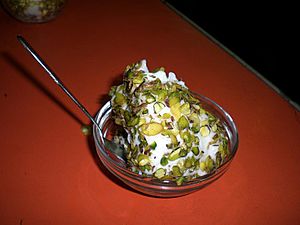
Modern Lebanese desserts have been influenced by Ottoman cuisine and are similar to those in neighboring countries. Semolina is used in many famous Lebanese desserts.
- Muhallebi is a milk pudding made with rice, milk, and sugar. Like many Lebanese desserts, it's sweetened with attar syrup and topped with different nuts.
- Barazeh (also found in Syrian cuisine) are light, crumbly cookies. One side is decorated with sesame seeds, and the other with pistachios.
- Ma'amoul are crumbly cookies filled with pistachios, walnuts, or dates. Lebanese Christians serve ma'amoul with atar syrup for Easter, along with a cake flavored with anise and mahlab.
- Halawet el jibn is filled with sweetened cheese and topped with atar, pistachios, clotted cream (ashta), and rose jam.
- Baklawa is made of layered pastry filled with nuts and soaked in attar syrup (orange or rose water and sugar). It's usually cut into triangular or diamond shapes, a style that started in Lebanon.
- Znoud al-sit is a syrup-soaked rolled pastry filled with clotted cream and garnished with nuts, orange peels, and dates. This dessert dates back to the 19th century.
- Kanafeh is a dessert stuffed with white cheese (like akkawi cheese), nuts, and syrup made with kadayif dough.
- Karabij (or Aleppo cookies) are flavored with mahlab and cinnamon, and topped with natef, which is similar to meringue.
- Mafroukeh is a semolina dough layered with caramel and butter, soaked in atar, and served with clotted cream and assorted nuts. It can also be used to make cakes like nammoura.
- Sfouf is a cake made with semolina flour and turmeric. It's often eaten on birthdays, family reunions, and religious holidays.
- Booza is a type of ice cream often called Arabic ice cream. It's full of Middle Eastern flavors. It's traditionally made by pounding and stretching in a freezer drum, rather than the usual churning method. Lebanese ice cream is popular for its eastern flavors, including amar al-din made from dried apricot paste.
Sauces and Spices
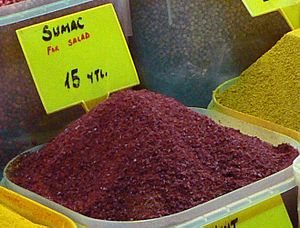
- Tahini – a paste made from sesame seeds.
- Tarator – a dip made from tahini, water, garlic, and lemon.
- Toum – a creamy garlic sauce.
- Shatta – a chili sauce popular in the Middle East.
- Muhammara – a hot pepper dip originally from Aleppo, Syria, found in Levantine and Turkish cuisines.
- Sumac – a tangy spice used in many salads.
- Za'atar – a mix of dried thyme and sumac. It can be different from region to region and family to family. Most are made at home, but you can buy them in Lebanese shops.
- Lebanese spice blend (also called Lebanese seven spice) – a mix of equal parts of allspice, black pepper, cinnamon, cloves, fenugreek, nutmeg, and ginger. It's commonly used to flavor many Lebanese dishes.
Popular Drinks
- Arabic coffee, black coffee, and Turkish coffee.
- Lebanese beer, which also includes non-alcoholic versions made with malt.
- Arak – an alcoholic drink.
- Ayran – a yogurt drink.
- Non-alcoholic drink made from the carob tree.
- Jallab – a sweet drink made from carob, dates, grape molasses, and rose water.
- Lebanese wine – Lebanon is one of the oldest places where wine was made! The Phoenicians, who lived on Lebanon's coast long ago, helped spread wine and winemaking throughout the Mediterranean. Lebanon's Beqaa Valley has more than 30 vineyards, including famous ones like Kefraya, Ksara, and Château Musar.
- Mate – a drink rich in caffeine. It's often consumed in Shouf and Aley. It's thought to have been brought back by Lebanese immigrants returning home from Argentina, where its main ingredients are grown.
See also
 In Spanish: Gastronomía del Líbano para niños
In Spanish: Gastronomía del Líbano para niños


